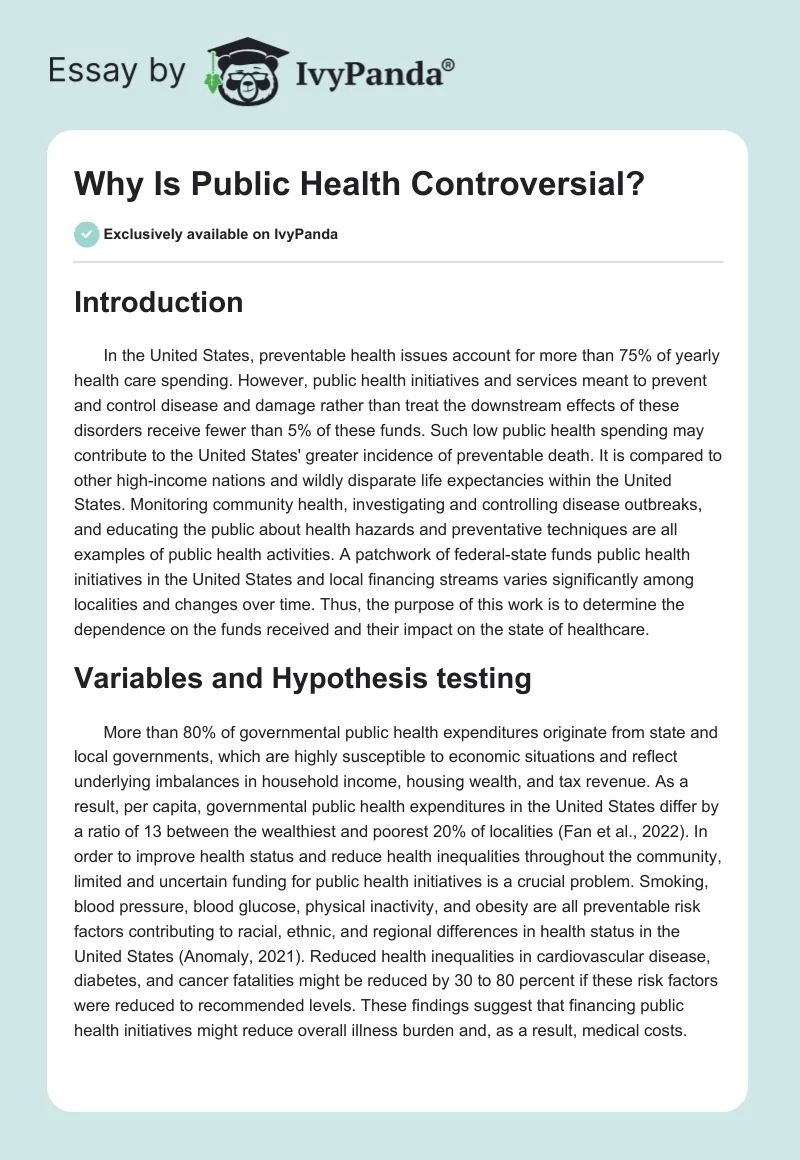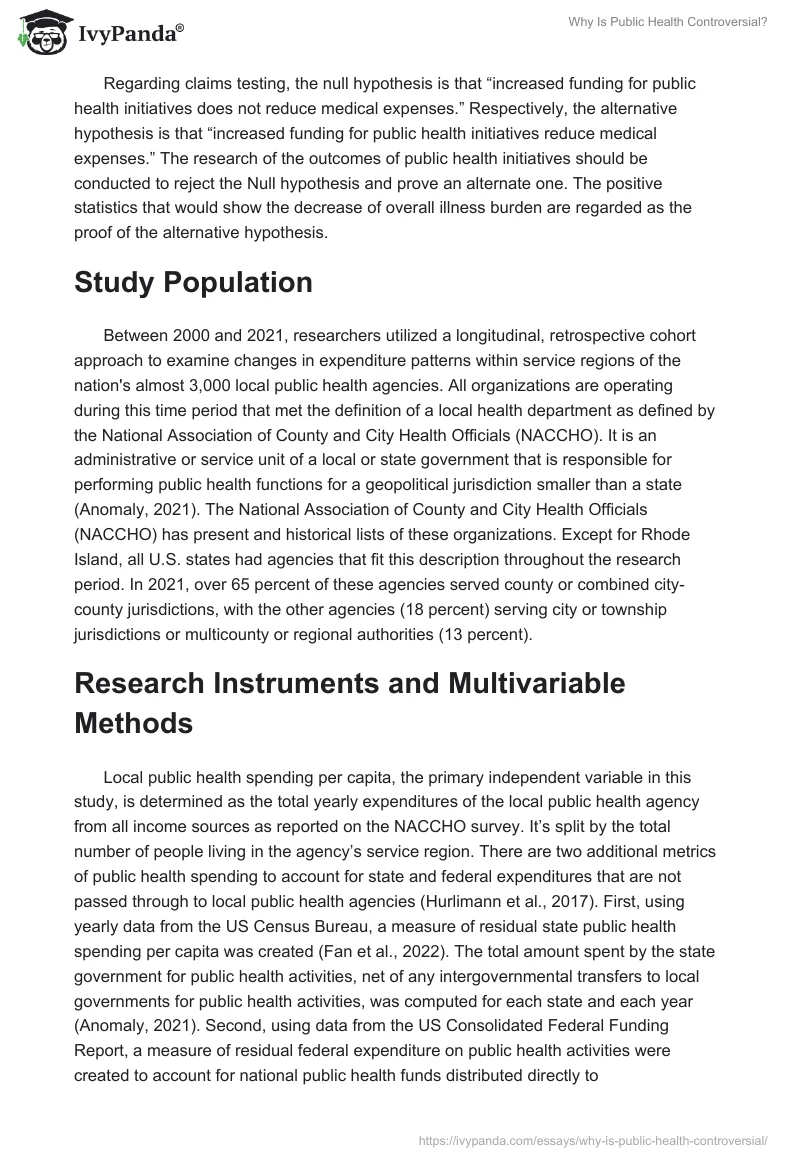Introduction
In the United States, preventable health issues account for more than 75% of yearly health care spending. However, public health initiatives and services meant to prevent and control disease and damage rather than treat the downstream effects of these disorders receive fewer than 5% of these funds. Such low public health spending may contribute to the United States’ greater incidence of preventable death. It is compared to other high-income nations and wildly disparate life expectancies within the United States. Monitoring community health, investigating and controlling disease outbreaks, and educating the public about health hazards and preventative techniques are all examples of public health activities. A patchwork of federal-state funds public health initiatives in the United States and local financing streams varies significantly among localities and changes over time. Thus, the purpose of this work is to determine the dependence on the funds received and their impact on the state of healthcare.
Variables and Hypothesis testing
More than 80% of governmental public health expenditures originate from state and local governments, which are highly susceptible to economic situations and reflect underlying imbalances in household income, housing wealth, and tax revenue. As a result, per capita, governmental public health expenditures in the United States differ by a ratio of 13 between the wealthiest and poorest 20% of localities (Fan et al., 2022). In order to improve health status and reduce health inequalities throughout the community, limited and uncertain funding for public health initiatives is a crucial problem. Smoking, blood pressure, blood glucose, physical inactivity, and obesity are all preventable risk factors contributing to racial, ethnic, and regional differences in health status in the United States (Anomaly, 2021). Reduced health inequalities in cardiovascular disease, diabetes, and cancer fatalities might be reduced by 30 to 80 percent if these risk factors were reduced to recommended levels. These findings suggest that financing public health initiatives might reduce overall illness burden and, as a result, medical costs.
Regarding claims testing, the null hypothesis is that “increased funding for public health initiatives does not reduce medical expenses.” Respectively, the alternative hypothesis is that “increased funding for public health initiatives reduce medical expenses.” The research of the outcomes of public health initiatives should be conducted to reject the Null hypothesis and prove an alternate one. The positive statistics that would show the decrease of overall illness burden are regarded as the proof of the alternative hypothesis.
Study Population
Between 2000 and 2021, researchers utilized a longitudinal, retrospective cohort approach to examine changes in expenditure patterns within service regions of the nation’s almost 3,000 local public health agencies. All organizations are operating during this time period that met the definition of a local health department as defined by the National Association of County and City Health Officials (NACCHO). It is an administrative or service unit of a local or state government that is responsible for performing public health functions for a geopolitical jurisdiction smaller than a state (Anomaly, 2021). The National Association of County and City Health Officials (NACCHO) has present and historical lists of these organizations. Except for Rhode Island, all U.S. states had agencies that fit this description throughout the research period. In 2021, over 65 percent of these agencies served county or combined city-county jurisdictions, with the other agencies (18 percent) serving city or township jurisdictions or multicounty or regional authorities (13 percent).
Research Instruments and Multivariable Methods
Local public health spending per capita, the primary independent variable in this study, is determined as the total yearly expenditures of the local public health agency from all income sources as reported on the NACCHO survey. It’s split by the total number of people living in the agency’s service region. There are two additional metrics of public health spending to account for state and federal expenditures that are not passed through to local public health agencies (Hurlimann et al., 2017). First, using yearly data from the US Census Bureau, a measure of residual state public health spending per capita was created (Fan et al., 2022). The total amount spent by the state government for public health activities, net of any intergovernmental transfers to local governments for public health activities, was computed for each state and each year (Anomaly, 2021). Second, using data from the US Consolidated Federal Funding Report, a measure of residual federal expenditure on public health activities were created to account for national public health funds distributed directly to nongovernmental grantees and hence not included in the local and state spending measures.
The multivariable methods that can be used to conduct regression analysis and prove alternate and reject null hypotheses are the following. Confounding or distortion is the method of finding interest or the measure of association, which is based on determining variables. The other method is a stratified analysis, needed to examine the primary association of interest at different levels of confounding factors. The next one is the Cochran-Mantel-Haenszel method, which needed to generate an association between an exposure and an outcome after considering confounding. The techniques described can be effectively used to proceed with data for results of public activities finding, to prove or reject the null hypothesis.
Statistical Tests and Results
In 2021, the average community’s public health spending increased to more than $45 per capita, up from $40 in 2000. During that time, the average annual growth rate in local public health spending was less than 1.5 percent in constant currency. Throughout the study, 65 percent of towns saw increased per capita public health spending, with an average rise of $4.23 per capita (Knai et al., 2018). However, 45 percent of localities saw budget cuts during this time, with an average loss of more than $13 per capita. Spending levels vary greatly per community, ranging from less than $1 per capita in 2010 to more than $500 per capita in 2021 (Choi et al., 2020). In 2021, the Gini coefficient of 0.55 showed a relatively high degree of inequality in local public health expenditure among communities, nearly echoing the level of economic disparity seen among American households. Therefore, it may be considered that in communities with low life quality level, increased funding results in illness burden relief, which proves alternate hypothesis.
Conclusion
The findings show that Medicare spending offsets are more prominent in low-resource communities, such as those with more poverty, poorer health insurance coverage, and a significant scarcity of health professionals. One probable explanation for these findings is that health promotion and disease prevention initiatives supported by public health expenditures benefit low-income communities disproportionately. The results suggest that hospitals, medical practices, and health plans carefully consider how public health agencies can assist in achieving the improved outcomes and lower costs required for financial success under these models.
Public health is divisive because, depending on how it is defined, it may question people’s values and necessitate compromises. Because initiatives in this sector have an economic consequence, they are frequently contentious. The people or industries that are forced to pay the price may not be the ones who profit from the increased safeguards. Therefore, in this case, the main recommendation will be the creation of new models of public health. New payment models including accountable care organizations (ACOs), shared savings agreements, and value-based payment schemes give clinicians and health plans more flexibility. It is demonstrated in implementing communitywide public health activities into their Medicare strategy and new funding alternatives.
References
Anomaly J. (2021). What is public health? public goods, publicized goods, and the conversion problem. Public Choice, 1–11. Web.
Choi, H., Cho, W., Kim, M. H., & Hur, J. Y. (2020). Public Health Emergency and Crisis Management: Case Study of SARS-CoV-2 Outbreak.International Journal of Environmental Research and Public Health, 17(11), 3984. Web.
Fan, Y., Fang, M., Zhang, X., & Yu, Y. (2022). Will the economic growth benefit public health? Health vulnerability, urbanization and COVID-19 in the USA.The Annals of Regional Science, 1–19. Web.
Hurlimann, T., Peña-Rosas, J. P., Saxena, A., Zamora, G., & Godard, B. (2017). Ethical issues in the development and implementation of nutrition-related public health policies and interventions: A scoping review.PloS One, 12(10), e0186897. Web.
Knai, C., Petticrew, M., Douglas, N., Durand, M. A., Eastmure, E., Nolte, E., & Mays, N. (2018). The public health responsibility deal: Using a systems-level analysis to understand the lack of impact on alcohol, food, physical activity, and workplace health sub-systems.International Journal of Environmental Research and Public Health, 15(12), 2895. Web.


